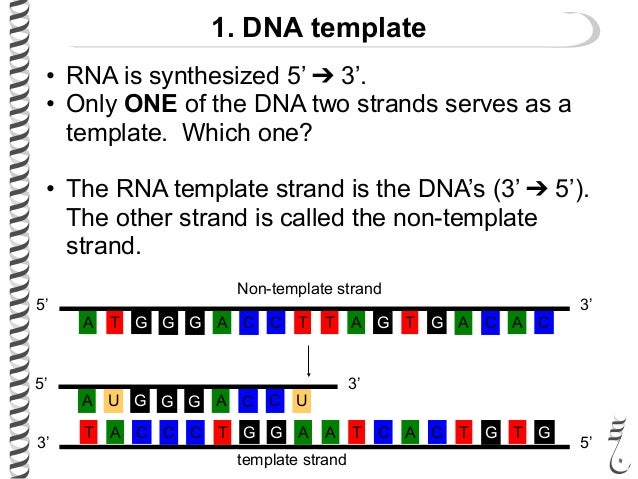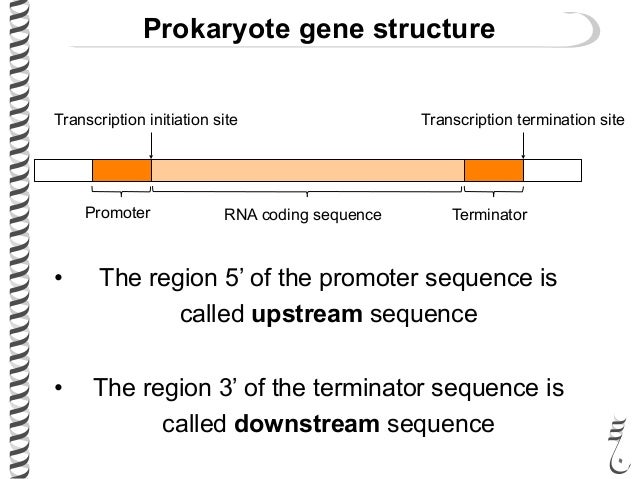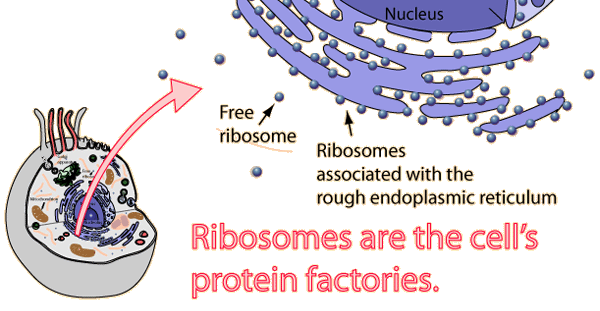How does RNA differ from DNA?

- RNA is single stranded
- Sugar ribose replaces deoxyribose
- uracil replace thymine in the nucleotides

What are the three types or RNA?

What is transcription?
Copying of genetic information from the form of DNA to the form of RNA. Process that creates RNA from DNA using RNA polymerase. Think of it like this: you want to cook something, DNA is the cookbook that belongs to your friend(living in the nucleus), you can't take the book with you, so instead you copy the recipe down on a note card to take home(to the cytoplasm) (RNA.)
What are the steps of transcription?
1. Initation
2. Elongation
3.Termination
4.Posttranscription modification

What is a promoter?

Extra chunk of DNA sequence (located upstream 5' from the DNA region that contains the info to be transcribed into mRNA, and from the initiation start site. it doesn't code for anything, it is just a signal)
- It marks where transcription should begin and where RNA polymerase binds and prys the strands apart to start producing RNA from the template strand
What is the template strand VS the coding strand
- The template strand of DNA is used as a stamp essentially in which RNA polymerase uses to build the mRNA strand
- The coding strand is the other strand that actually possess the code. The mRNA strand actually matches the coding strand but it uses U instead of T
What is RNA Polymerase?

An enzyme that catalyzes the synthesis of an RNA strand from a DNA template.
In eukaryotes, there are several classes of RNA polymerase. It assembles the individual nucleotides to create the RNA strand based on the DNA templet. It zips the DNA back up as it moves along the strand. It does not require a primer to imitate.
In what direction does the RNA polymerase read the DNA template strand?
In what direction does RNA polymerase synthesize and build

- RNA polymerase binds to the 3' end of the template and travels down to the 5'
- polymerase synthesizes in the 5' to 3' direction
- new nucleotides can ONLY be added in the 5'--->3' direction and new stuff can only be added to the growing 3' end
What are the RNA polymerase in eukaryotic cells

What is the job of RNA polymerase 1?
responsible for transcribing RNA that codes for genes that become structural components of the ribosome, a protein responsible for the translation of RNA into proteins.
What is the job of RNA polymerase 2?
RNA polymerase II transcribes protein-encoding genes, or messenger RNAs, which are the RNAs that get translated into proteins
What is the job of RNA polymerase 3?
transcribes a different structural region of the ribosome, transfer RNAs, which are also involved the translation process, as well as non-protein encoding RNAs.
What is RNA polymerase in bacteria

Called holoenzyme and contains many subunits
- the sigma fact plays a regulatory function in the invitation of RNA transcriptase
- Scans DNA until sigma unit recognizes and binds promoter
What part of the RNA polymerase molecule is responsible for recognizing the promoter region of DNA in bacteria?
The sigma subunit
Can eukaryotic polymerase recognize a promoter region easily?
NO, eukaryotic polymerases are unable to recognize promoter regions. They have no direct parallel to the sigma subunit of their prokaryotic counterpart. Instead, eukaryotic polymerases depend on other proteins that bind to the promoter regions and then recruit the RNA polymerases to the correct spots.
What do eukaryotic polymerase use to recognize a promoter region?
the TATA box, the CAAT box, or the GC box, which all act as binding sites for specific transcription factors that will then recruit the correct polymerase
- most important polymerase II transcription factor= TATA binding protein that binds to the TATA box promoter
What are transcription factors?
Transcription factors are proteins involved in the process of converting, or transcribing, DNA into RNA. Transcription factors include a wide number of proteins, excluding RNA polymerase, that initiate and regulate the transcription of genes.

Terms upstream and downstream are commonly used when discussing the location of specific loci


Examples of census sequences
TATA box is a DNA sequence located on the nontemplate strand, upstream from transcription start site. that indicates where a genetic sequence can be read and decoded. It is a type of promoter sequence, which specifies to other molecules where transcription begins. TATATA rich because easier to break apart because of 2 hydrogen bonds.
CCAAT box (also sometimes abbreviated a CAAT box or CAT box) is a distinct pattern of nucleotides with GGCCAATCT consensus sequence that occur upstream by 60-100 bases to the initial transcription site.
Both are Cis acting elements.
The Pribnow box (also known as the Pribnow-Schaller box) is the sequence TATAAT of six nucleotides (thymine-adenine-thymine-etc.) that is an essential part of a promoter site on DNA for transcription to occur in bacteria. located -10
When we give consensus sequences, we give the sequence of the coding strand. For example, the Pribnow box (-10) sequence is: 5’ TATAAT 3’
- E coli promoters have two consensus sequences located where
positioned at -35 and -10 with respect to the transcription initiation site.
What would happen if a mutation occurred in the consensus sequences?
transcription levels would decrease
Cis acting vs trans acting elements
Cis-regulatory elements are often binding sites for one or more trans-actingfactors.
- Cis-acting elements - DNA sequences in the vicinity of the structural portion of a gene that are required for gene expression
- Trans-acting factors - factors, usually considered to be proteins, that bind to the cis-acting sequences to control gene expression
Do all promoters have the same CIs elements
NO
What takes place in the first step on transcription: initation

- the enzyme explores the length of DNA till it recognizes a promoter region located upstream(toward 5' end of DNA) from the transcription start point that contains a TATA box, A's and T's because they only have 2 hydrogen bonds and are easier to break apart
- several transcription factors must bind to the DNA before RNA polymerase II can
- RNA polymerase II binds and forms the transcription initation complex and unwinding happens
Is a primer necessary for RNA polymerase to start synthesizing in the second step of transcription known as elongation?
NO, not necessary, the RNA polymerase just keeps synthesizing and adding to that 3 prime end of mRNA during elongation
For a given gene, one strand serves as the template, but...
either strand can be the template depending on which direction(left or right) it says the DNA is being read or the RNA is being synthesized.
Different strands of the double helix DNA are used as the template for different genes
The location of the promoter will dictate the site of RNA Polymerase binding and direction of transcription
RNA polymerase stops transcribing when what happens?
When it reaches the termination sequence. It is different in prokaryotic bacteria and eukaryotic
How does termination happen in prokaryotes?
RNA synthesis will continue along the DNA template strand until the polymerase encounters a signal that tells it to stop, or terminate, transcription. In prokaryotes, this signal can take two forms, rho-independent and rho-dependent.
What is the rho-independent terminator in bacteria?
(intrinsic)

RNA can fold back and base pair with itself forming a hairpin loop. the string of adenines in the DNA sequence are transcribed into uracils in the RNA sequence. Because the uracil bases will only pair weakly with the adenines, the RNA chain can easily be released from the DNA template, terminating transcription.
In the hairpin loop, what is the purpose of the strong GC bonds before the loop?
- Strong GC bonds hold structure together, causes a “stalling” of RNAP
- When RNAP stalls, the weak AU bonds don’t hold mRNA and DNA complex together
What is rho-dependent termination in bacteria?
rho-dependent terminator received its name because it is dependent on a specific protein called a rho factor. The rho factor is thought to bind to the end of the RNA chain and slide along the strand towards the open complex bubble. When the factor catches the polymerase, it causes the termination of transcription.
How is the chromatin different in prokaryotes vs eukaryotes in regards to transcription?
What about Cis acting elements and transacting factors?
- Chromatin needs to be “remodeled” in eukaryotes because the DNA is tightly wound up in histones because it has to uncoiled for the transcription to begin
- In eukaryotes, theres far more cis-elements beyond core promoter (silencers, enhancers, proximal elements,) and thus far more trans-acting factors.
Where are enhancers and silencers located in eukaryotic?
RNA rely on transcription factors, in addition to promoters, other control units enhancers and silencers that can be located in the 5' regulatory region upstream from initation point or 3' downstream region beyond coding sequence
Why needs to happen before RNA transcripts can be transported to the cytoplasm
They require significant alteration to become mature mRNA before they're transported to the cytoplasm, via post transcriptional modification
What takes place in postranscriptional modification?
- 5' cap of 7 methylguanosinn which protects from nuclease attack during the journey through the nuclear envelope into cytoplasm
- Poly A tail at the 3' end
If the 5’cap or poly A tail were missing from a eukaryotic mRNA, what would be the consequence

More prone to degradation/ lack of transport to cytoplasm
What is mRNA splicing?
- the reaction that removes unnecessary segments of the primary RNA transcript, called introns
- Messenger RNA contains only exons, those portions of the primary RNA transcript that will be translated into a protein.
How does mRNA splicing occur?

via spicisomes which are built up of small proteins+snRNA which would be found in the nucleus of a cell
What are the products of eukaryotic transcription compared to prokaryotic?
Eukaryotic transcription yields pre-mRNA or primary transcript RNA. Prokaryotic transcription yields mature RNA (mRNA)
What do the splicisomes do?

recognizes specific sequences in the DNA that will determine the sites of splicing
What is the name of protein coding segments of primary transcript RNA? Of non- protein coding segments? Which are conserved during the splicing reaction?
Exons are segments of primary transcript RNA that are conserved during the splicing reaction and code for proteins during translation. Introns are sequences that are not conserved and are spliced out during the splicing reaciton.
**UTR does NOT get spliced out!!!!
How many different genetic combinations can be made from the 3 nuleodite codons and how many amino acids do they code for?
- 64 possibilites
- 20 amino acids
- What is the start codon?
- What are the stop codons?

- AUG
- UAA, UAG, UGA
What is translation?
process that converts an mRNA sequence into a string of amino acids that form a protein
What are the 3 main steps of translation?
-
- Initiation- complex of ribosome, first charged tRNA, mRNA
- Elongation- peptide bonds formed as charged tRNAs bring appropriate amino acids to ribosome
- Termination- stop codons signal release factors and complex dissociates
What is the anticodon?

The sequence of three nucleotides located on the anticodon arm of the tRNA cloverleaf structure, the tRNA brings this anticodon with it. The anticodon bonds in antiparallel fashion with a codon of mRNA at the acceptor site of a ribosome during translation. This is like a lock and key, its how the tRNA knows its at the right spot, when the key fits!
Before translation can occur, what does tRNA need to be bound with?
An amino acid in two-step process is called "charging".
What is Adenylylation?
The first step in tRNA charging. Involves the "activation" of an amino acid so that the acid can be bound to a tRNA molecule. The process of activation involves the transfer of an AMP group from ATP to the amino acid.
Aminoacyl-tRNA synthase
- The enzyme that catalyzes the bond between specific tRNA and amino acid, to form aminoacyl tRNA.
- Charging of the tRNA with its specific amino acid is carried out by this
- Each aminoacyl-tRNA synthetase is highly specific for a given amino acid and for a given tRNA
Aminoacyl tRNA
A tRNA molecule that has been charged. It is loaded with an amino acid and is ready to participate in translation at the ribosome, where it binds to the acceptor site. Also known as charged tRNA
What is charging?
The two-step process in which an amino acid is "loaded" onto a tRNA. The first step is adenylylation; the second is the binding of tRNA and amino acid into an aminoacyl tRNA.

What is located at the 3' end of the tRNA?

At the 3' end of the tRNA molecule, opposite the anticodon, extends a three nucleotide acceptor site (that includes a free -OH group) known as the amino acid attachment site. A specific tRNA binds to a specific amino acid through its acceptor stem.
What do the ribosomes work as?

“as a nonspecific workbench for the translation process.”
What is rRNA's job in translation?
to assist in the binding processes between tRNA anticodon and mRNA codon
So what happens in initiation in translation?
- During initiation, the mRNA, the tRNA, and the first amino acid all come together within the ribosome.
- true initiation point is the start codon, AUG. Remember that the start codon is the set of three nucleotides that begins the coded sequence of a gene. Remember also that the start codon specifies the amino acid methionine. So, methionine is the name of the amino acid that is brought into the ribosome first.
- MET (fmet in bacteria) attaches to the tRNA that contains the right anticodon. The anticodon for AUG is UAC.
- The tRNA with the anticodon UAC will automatically match to the codon AUG, bringing the methionine along for the ride. The tRNA basically says HEY I HAVE AN AMINO ACID THAT MATCHES THIS SPECIFIC CODON, I ALSO HAVE YOUR ANTICODON, WHERE YOU AT CODON?
- So, there you have it - mRNA is attached to tRNA, and tRNA is attached to methionine. That's initiation.
When does codon recognition happen?
Codon recognition happens when tRNA pairs with the mRNA inside the ribosome.
example: AUG on the mRNA is the start codon, the anticodon on the tRNA that matches it would be UAC, and it codes for methionine
What does the chemical structure of an amino acid look like?

chemical structure of an amino acid, we see that one end contains a terminal nitrogen group while the other contains a carboxyl group.
Whats happening in elongation?

- amino acids are transferred from the aminoacyl tRNA in the A site to the growing protein chain attached to the P site
- they are transferred in a specific orientation so that the chain grows by adding amino acids to the carboxyl, not nitrogen, end of the chain.
- In this way, the protein chain grows in the nitrogen to carboxyl direction. This synthesized chain is called a polypeptide chain.
- synthesized N-terminus ------>C-Termnius direction because polypeptides are added to the C end
What is each amino acid being added called?

each amino acid added can be called a peptide; a building block of the larger polypeptide chain. Proteins are polypeptides.
What type of bond does addition occur through?
addition occurs through the formation of a peptide bond, the nitrogen-carbon bond that forms between amino acid subunits to form a polypeptide chain
Protein chain growth occurs in what direction?
N-terminus to carboxy-terminus
In which direction does the ribosome move along the mRNA molecule
- Ribosomes move along the mRNA molecule in the 5' to 3' direction.
- N terminal aligns with the 5' end of mRNA while C terminal aligns with the 3' end of mRNA.
- new stuff added to 3' end and C end remember that
- Same alignment with the coding strand (non template) and opposite for template
When does translation end and termination occur?
Translation ends when one of three stop codons, UAA, UAG, or UGA, enters the A site of the ribosome
Does a stop codon code for anything? UGA,UAG,UAA?
The three stop codons are UAA, UAG, and UGA. These codons signal translation termination because there is no tRNA molecule that recognizes these codons. Instead, they are recognized by termination factors that stop translation.